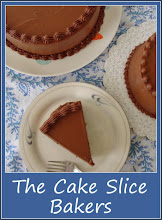The August 2011 Daring Bakers’ Challenge was hosted by Lisa of Parsley, Sage, Desserts and Line Drive and Mandy of What the Fruitcake?!. These two sugar mavens challenged us to make sinfully delicious candies! This was a special challenge for the Daring Bakers because the good folks at http://www.chocoley.com offered an amazing prize for the winner of the most creative and delicious candy!
This month’s challenge was fun. We were instructed to make two sorts of sweets/chocolates/candies of our own choosing. The only requirement was that one of them had to incorporate chocolate to make a truffle or bonbon, either in the outer shell or in the filling. The other sweet/candy was up to us.
I decided to incorporate chocolate into both my sweets, but using different varieties and in different forms. My first chocolate comprised of using white chocolate to form the outer shell of a filled bonbon. The filling of the bonbon was sweetened black bean paste that I snapped up a few weeks ago from an oriental supermarket. I’ve had red bean paste in Chinese pastries before and loved it, but I’d never seen the black bean variety. It comes in a can and was jet black in colour. It was rich and thick, with a slightly granular texture from the beans, yet sweet with a hint of rosewater that gave it a very delicate flavour. It resulted in a wonderful smooth sweet centre to the crisp white chocolate shell and I loved the black and white colour contrast too.
I used a silicone chocolate mould which helped create the shape and smooth glossy exterior to the chocolates. Plus, it meant they popped out easily when set.
My second sweetie was a thin dark chocolate disc topped with a whole pecan, some dried cranberries and slivers of crystallised ginger. I used a very bitter 85% dark chocolate which gave a wonderful rich chocolate flavour, delicious against the sweet tangy cranberries and the spicy ginger. The nut on top added another texture contrast and worked well with all the other flavours. They were so easy and quick to put together and looked quite stylish. I’ve seen similar things selling for extortionate amounts in shops, so it’s good to know I can produce similar results at home. They’d be great to serve to guests after dinner.
I really enjoyed the freedom we were given with this challenge and it was perfect for me this month as I have been so busy that I wouldn’t have been able to manage anything too time consuming. I love both the chocolates, both very different but equally delicious.
Click to see what tasty chocolate creations the other Daring Bakers made this month.
White Chocolate & Black Bean Truffles
Ingredients
100g white chocolate
10 tsp sweetened black bean paste (from oriental supermarkets)
Method
Melt 80g of the white chocolate and use a small pastry brush to coat the base and sides of small chocolate moulds. Make sure they are generously coated.
Place in the fridge for 5 minutes to chill and set.
Spoon a little of the black bean paste into the centre of the moulds, leaving a tiny gap at the top to allow you to seal them with extra chocolate.
Melt the remaining white chocolate and use to seal/cover the filling to create a white chocolate base to your chocolates.
Place back in the fridge for 10-15 minutes before turning out.
Store in the fridge until ready to serve.
Pecan, Cranberry & Ginger Dark Chocolate Discs
Ingredients
50g dark bitter chocolate (I used 85%)
10 pecan nuts
3 chunks of crystallised ginger, shredded
20g dried cranberries
Method
Draw small circle onto a sheet of paper. Place the paper on a baking tray and cover with clingfilm, so the circles show through underneath.
Melt the dark chocolate and spoon a little into the centre of each of the circles. Use the back of a teaspoon to spread the chocolate into the circle shapes.
While the chocolate is still soft, scatter over your choice of dried fruit and nuts.
Place in the fridge to set for 10 minutes.
Once set, carefully peel the chocolate discs off the clingfilm and store in the fridge until ready to serve.
Honey Baked Ham & How To Spiral Cut At Home
3 hours ago




















































